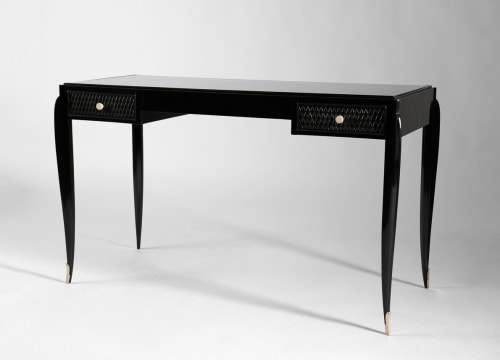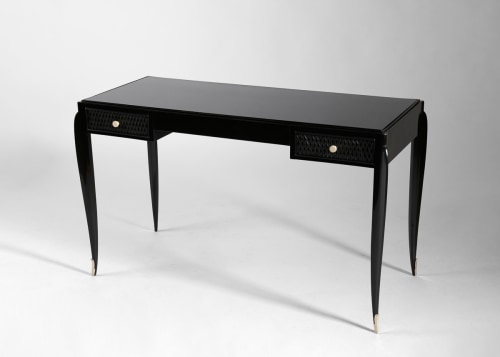

Jean Pascaud was born in Rouen in 1903. He took a degree in engineering from the Ecole Centrale des Arts et Manufactures, but his passion for furniture and décor, and the influence of his father in law, Auguste Bluysen, (then President of the Société des Architectes Modernes), led Pascaud to abandon a more traditional career and take up furniture design instead.
By the late 1920s Pascaud had begun creating furniture in earnest; and in no time he was exhibiting in various salons—presenting regularly at the Salon des Tuileries, at the Salon d'Automne, the Salon des Artistes Décorateurs, and the Arts Ménagers.
Like other great designers of his era Jean Pascaud was as much a traditionalist as an innovator. He shied away from the bland, in-styles of the 1930s. His work is simple, yet technically ambitious and brilliant; his pieces are impressively large, but aesthetically balanced. Like Paul Dupré-Lafon, Jacques Adnet, and André Arbus, with whom he is frequently mistaken, Pascaud adorned his elegant, simple designs with accents of graphics or ornaments (frequently in the form of prominent medallions, after the fashion of his celebrated predecessor, Ruhlmann), or with exotic woods, paneling, parchment, galuchat, veneers, or upholstery. Like Arbus, Pascaud collaborated with prominent craftsmen (Mme Bouissou, Léon Lang, and Pierre Lardin, to name a few), to produce these noble effects—and, in fact, much of Pascaud’s most distinct work is the product of these remarkable collaborative efforts.
As the 1930s pressed on, and Pascaud’s reputation grew, he exhibited less and less frequently. By the time he secured the Grand Prix at the International Exposition of 1937 he had traded in exhibiting almost entirely for private commissions and comprehensive decorative projects. In 1934 he decorated the Dieppe suite of the ocean liner The Normandy. Next he took on another ocean liner, The Pasteur. In 1937 Pascaud was commissioned to redecorate the offices of the French Ministry of Education. Jean Zay, then Minister of Public Education, was so impressed with Pascaud’s work that he commissioned the designer to redo his offices at the Rochechouart Hotel in Paris.
By the 1940's large commissions of this kind were hardly unusual for Jean Pascaud. He was a renowned designer and decorator, and, securely atop his field, had developed a prestigious clientele that ranged from wealthy individuals to corporations and departments of government. In 1948 he completed the monument at the Place de Landhaus in Insbruck, and, in 1949, the Col de l'Arlberg. As the decade drew to a close he designed the French embassies in Czechoslovakia, Sweden, and Mexico as well.
Jean Pascaud was made a Chevalier of the Legion of Honor in 1952.